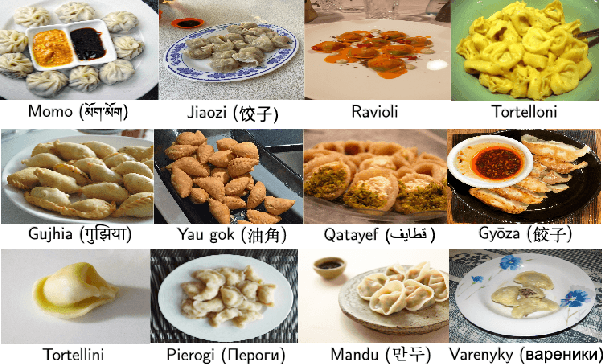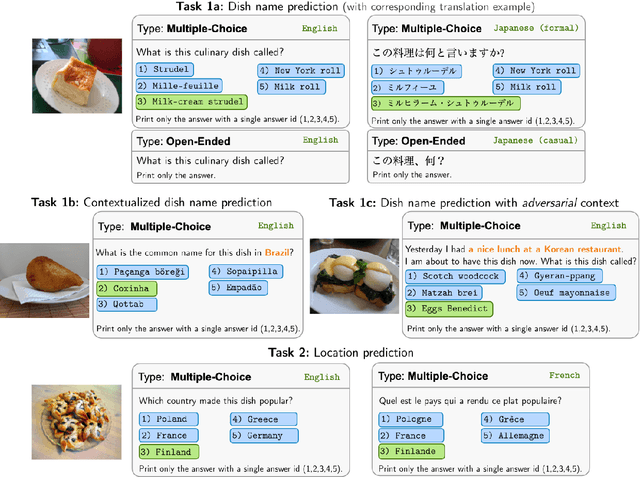Bryan Wilie
High-Dimensional Interlingual Representations of Large Language Models
Mar 14, 2025Abstract:Large language models (LLMs) trained on massive multilingual datasets hint at the formation of interlingual constructs--a shared subspace in the representation space. However, evidence regarding this phenomenon is mixed, leaving it unclear whether these models truly develop unified interlingual representations, or present a partially aligned constructs. We explore 31 diverse languages varying on their resource-levels, typologies, and geographical regions; and find that multilingual LLMs exhibit inconsistent cross-lingual alignments. To address this, we propose an interlingual representation framework identifying both the shared interlingual semantic subspace and fragmented components, existed due to representational limitations. We introduce Interlingual Local Overlap (ILO) score to quantify interlingual alignment by comparing the local neighborhood structures of high-dimensional representations. We utilize ILO to investigate the impact of single-language fine-tuning on the interlingual representations in multilingual LLMs. Our results indicate that training exclusively on a single language disrupts the alignment in early layers, while freezing these layers preserves the alignment of interlingual representations, leading to improved cross-lingual generalization. These results validate our framework and metric for evaluating interlingual representation, and further underscore that interlingual alignment is crucial for scalable multilingual learning.
WorldCuisines: A Massive-Scale Benchmark for Multilingual and Multicultural Visual Question Answering on Global Cuisines
Oct 16, 2024



Abstract:Vision Language Models (VLMs) often struggle with culture-specific knowledge, particularly in languages other than English and in underrepresented cultural contexts. To evaluate their understanding of such knowledge, we introduce WorldCuisines, a massive-scale benchmark for multilingual and multicultural, visually grounded language understanding. This benchmark includes a visual question answering (VQA) dataset with text-image pairs across 30 languages and dialects, spanning 9 language families and featuring over 1 million data points, making it the largest multicultural VQA benchmark to date. It includes tasks for identifying dish names and their origins. We provide evaluation datasets in two sizes (12k and 60k instances) alongside a training dataset (1 million instances). Our findings show that while VLMs perform better with correct location context, they struggle with adversarial contexts and predicting specific regional cuisines and languages. To support future research, we release a knowledge base with annotated food entries and images along with the VQA data.
LLM Internal States Reveal Hallucination Risk Faced With a Query
Jul 03, 2024Abstract:The hallucination problem of Large Language Models (LLMs) significantly limits their reliability and trustworthiness. Humans have a self-awareness process that allows us to recognize what we don't know when faced with queries. Inspired by this, our paper investigates whether LLMs can estimate their own hallucination risk before response generation. We analyze the internal mechanisms of LLMs broadly both in terms of training data sources and across 15 diverse Natural Language Generation (NLG) tasks, spanning over 700 datasets. Our empirical analysis reveals two key insights: (1) LLM internal states indicate whether they have seen the query in training data or not; and (2) LLM internal states show they are likely to hallucinate or not regarding the query. Our study explores particular neurons, activation layers, and tokens that play a crucial role in the LLM perception of uncertainty and hallucination risk. By a probing estimator, we leverage LLM self-assessment, achieving an average hallucination estimation accuracy of 84.32\% at run time.
Belief Revision: The Adaptability of Large Language Models Reasoning
Jun 28, 2024



Abstract:The capability to reason from text is crucial for real-world NLP applications. Real-world scenarios often involve incomplete or evolving data. In response, individuals update their beliefs and understandings accordingly. However, most existing evaluations assume that language models (LMs) operate with consistent information. We introduce Belief-R, a new dataset designed to test LMs' belief revision ability when presented with new evidence. Inspired by how humans suppress prior inferences, this task assesses LMs within the newly proposed delta reasoning ($\Delta R$) framework. Belief-R features sequences of premises designed to simulate scenarios where additional information could necessitate prior conclusions drawn by LMs. We evaluate $\sim$30 LMs across diverse prompting strategies and found that LMs generally struggle to appropriately revise their beliefs in response to new information. Further, models adept at updating often underperformed in scenarios without necessary updates, highlighting a critical trade-off. These insights underscore the importance of improving LMs' adaptiveness to changing information, a step toward more reliable AI systems.
High-Dimension Human Value Representation in Large Language Models
Apr 11, 2024



Abstract:The widespread application of Large Language Models (LLMs) across various tasks and fields has necessitated the alignment of these models with human values and preferences. Given various approaches of human value alignment, ranging from Reinforcement Learning with Human Feedback (RLHF), to constitutional learning, etc. there is an urgent need to understand the scope and nature of human values injected into these models before their release. There is also a need for model alignment without a costly large scale human annotation effort. We propose UniVaR, a high-dimensional representation of human value distributions in LLMs, orthogonal to model architecture and training data. Trained from the value-relevant output of eight multilingual LLMs and tested on the output from four multilingual LLMs, namely LlaMA2, ChatGPT, JAIS and Yi, we show that UniVaR is a powerful tool to compare the distribution of human values embedded in different LLMs with different langauge sources. Through UniVaR, we explore how different LLMs prioritize various values in different languages and cultures, shedding light on the complex interplay between human values and language modeling.
Cendol: Open Instruction-tuned Generative Large Language Models for Indonesian Languages
Apr 09, 2024



Abstract:Large language models (LLMs) show remarkable human-like capability in various domains and languages. However, a notable quality gap arises in low-resource languages, e.g., Indonesian indigenous languages, rendering them ineffective and inefficient in such linguistic contexts. To bridge this quality gap, we introduce Cendol, a collection of Indonesian LLMs encompassing both decoder-only and encoder-decoder architectures across a range of model sizes. We highlight Cendol's effectiveness across a diverse array of tasks, attaining 20% improvement, and demonstrate its capability to generalize to unseen tasks and indigenous languages of Indonesia. Furthermore, Cendol models showcase improved human favorability despite their limitations in capturing indigenous knowledge and cultural values in Indonesia. In addition, we discuss the shortcomings of parameter-efficient tunings, such as LoRA, for language adaptation. Alternatively, we propose the usage of vocabulary adaptation to enhance efficiency. Lastly, we evaluate the safety of Cendol and showcase that safety in pre-training in one language such as English is transferable to low-resource languages, such as Indonesian, even without RLHF and safety fine-tuning.
Contrastive Learning for Inference in Dialogue
Oct 19, 2023Abstract:Inference, especially those derived from inductive processes, is a crucial component in our conversation to complement the information implicitly or explicitly conveyed by a speaker. While recent large language models show remarkable advances in inference tasks, their performance in inductive reasoning, where not all information is present in the context, is far behind deductive reasoning. In this paper, we analyze the behavior of the models based on the task difficulty defined by the semantic information gap -- which distinguishes inductive and deductive reasoning (Johnson-Laird, 1988, 1993). Our analysis reveals that the disparity in information between dialogue contexts and desired inferences poses a significant challenge to the inductive inference process. To mitigate this information gap, we investigate a contrastive learning approach by feeding negative samples. Our experiments suggest negative samples help models understand what is wrong and improve their inference generations.
InstructTODS: Large Language Models for End-to-End Task-Oriented Dialogue Systems
Oct 13, 2023Abstract:Large language models (LLMs) have been used for diverse tasks in natural language processing (NLP), yet remain under-explored for task-oriented dialogue systems (TODS), especially for end-to-end TODS. We present InstructTODS, a novel off-the-shelf framework for zero-shot end-to-end task-oriented dialogue systems that can adapt to diverse domains without fine-tuning. By leveraging LLMs, InstructTODS generates a proxy belief state that seamlessly translates user intentions into dynamic queries for efficient interaction with any KB. Our extensive experiments demonstrate that InstructTODS achieves comparable performance to fully fine-tuned TODS in guiding dialogues to successful completion without prior knowledge or task-specific data. Furthermore, a rigorous human evaluation of end-to-end TODS shows that InstructTODS produces dialogue responses that notably outperform both the gold responses and the state-of-the-art TODS in terms of helpfulness, informativeness, and humanness. Moreover, the effectiveness of LLMs in TODS is further supported by our comprehensive evaluations on TODS subtasks: dialogue state tracking, intent classification, and response generation. Code and implementations could be found here https://github.com/WillyHC22/InstructTODS/
NusaWrites: Constructing High-Quality Corpora for Underrepresented and Extremely Low-Resource Languages
Sep 20, 2023



Abstract:Democratizing access to natural language processing (NLP) technology is crucial, especially for underrepresented and extremely low-resource languages. Previous research has focused on developing labeled and unlabeled corpora for these languages through online scraping and document translation. While these methods have proven effective and cost-efficient, we have identified limitations in the resulting corpora, including a lack of lexical diversity and cultural relevance to local communities. To address this gap, we conduct a case study on Indonesian local languages. We compare the effectiveness of online scraping, human translation, and paragraph writing by native speakers in constructing datasets. Our findings demonstrate that datasets generated through paragraph writing by native speakers exhibit superior quality in terms of lexical diversity and cultural content. In addition, we present the \datasetname{} benchmark, encompassing 12 underrepresented and extremely low-resource languages spoken by millions of individuals in Indonesia. Our empirical experiment results using existing multilingual large language models conclude the need to extend these models to more underrepresented languages. We release the NusaWrites dataset at https://github.com/IndoNLP/nusa-writes.
PICK: Polished & Informed Candidate Scoring for Knowledge-Grounded Dialogue Systems
Sep 19, 2023Abstract:Grounding dialogue response generation on external knowledge is proposed to produce informative and engaging responses. However, current knowledge-grounded dialogue (KGD) systems often fail to align the generated responses with human-preferred qualities due to several issues like hallucination and the lack of coherence. Upon analyzing multiple language model generations, we observe the presence of alternative generated responses within a single decoding process. These alternative responses are more faithful and exhibit a comparable or higher level of relevance to prior conversational turns compared to the optimal responses prioritized by the decoding processes. To address these challenges and driven by these observations, we propose Polished \& Informed Candidate Scoring (PICK), a generation re-scoring framework that empowers models to generate faithful and relevant responses without requiring additional labeled data or model tuning. Through comprehensive automatic and human evaluations, we demonstrate the effectiveness of PICK in generating responses that are more faithful while keeping them relevant to the dialogue history. Furthermore, PICK consistently improves the system's performance with both oracle and retrieved knowledge in all decoding strategies. We provide the detailed implementation in https://github.com/bryanwilie/pick .
 Add to Chrome
Add to Chrome Add to Firefox
Add to Firefox Add to Edge
Add to Edge